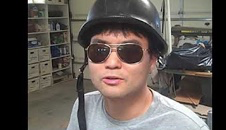Organizational Research Methods: Storytelling in ActionDavid M. Boje Book being prepared for Routledge, due March 2018 To cite this document: Boje, David M. (2018) "Organizational Resarch Methods: Storytelling In Action", (March 15), URL = <https://davidboje.com/ORM_Storytelling_in_Action_Book/index> |
STREAM 1 Søren Brier's Peircean Cybersemiotics
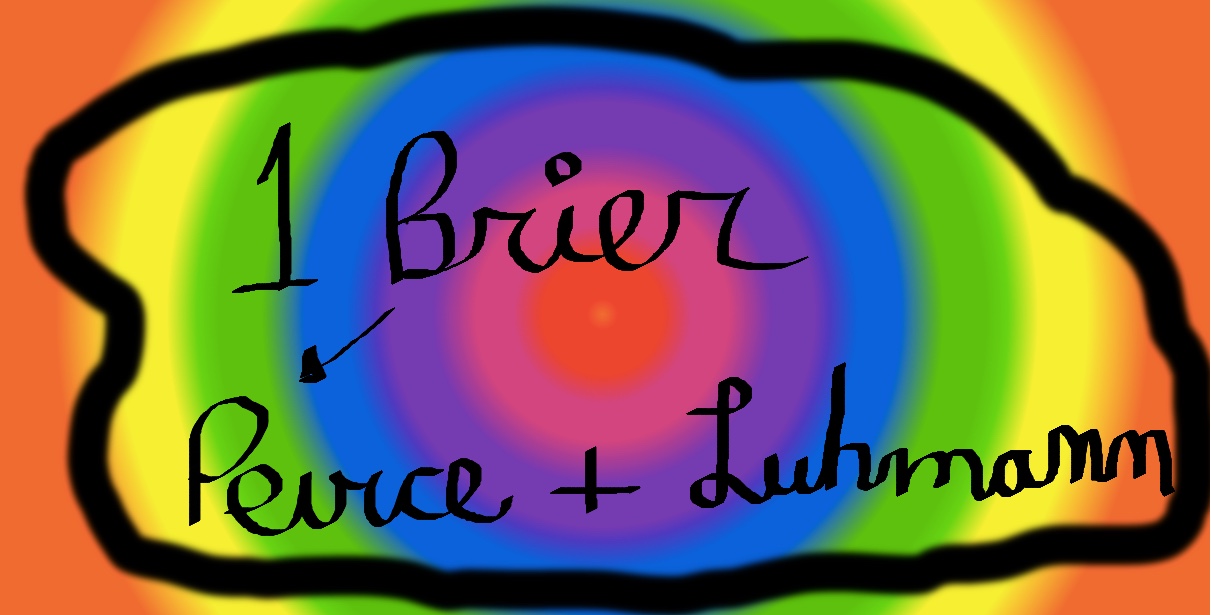
Søren Brier is a Peircean scholar who integrates Charles Sanders Pierce's semiology with Niklas Luhmann's cybernetic systems theory (triadic autopoiesis model of communication.), to fashion the hybrid integrative theory of 'cybersemiotics'.
new final version https://youtu.be/tuSpVk8rZzY
Retheorizing TQM with Søren Brier's Cybersemiotics with Harley quality application
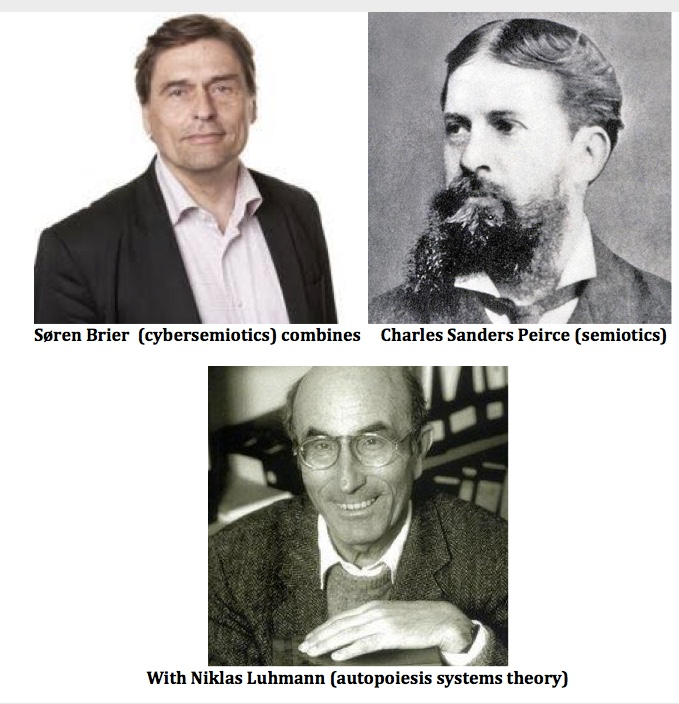
We embody matter and energy that is physical, chemical, biological, and spiritual. Søren Brier’s four-legged Star captures what we have in mind for quantum storytelling consultancy to living systems in relation to inner life/consciousness, sense/meaning, and matter/energy. In the middle of Brier’s (2010) Star Model is the observing system (e.g. an awareness apparatus), which gives the storytelling account of reality using various methods to capture the dominant narrative.

Boje 1st HAWG
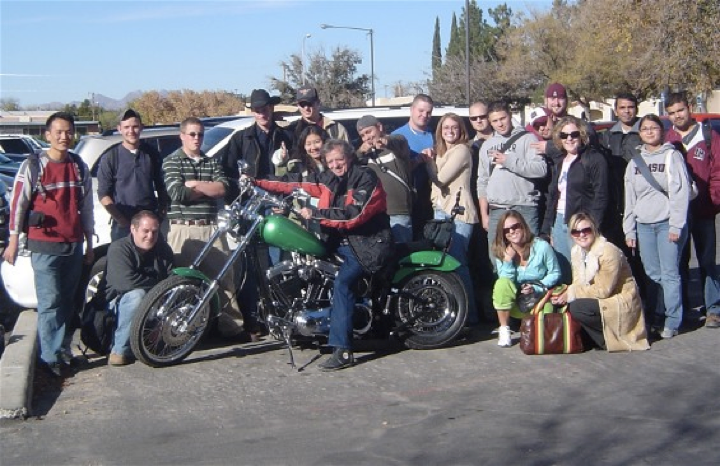
Boje's 2005 homebuilt Green Harley Chopper
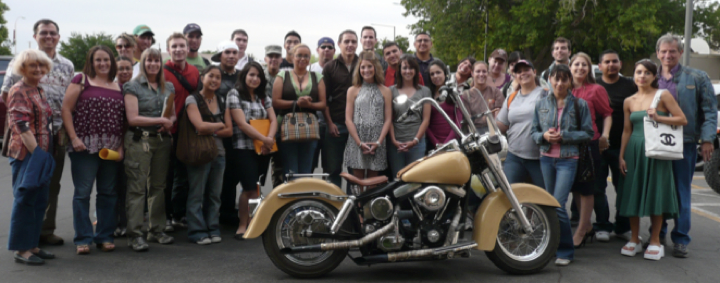
Boje's rebuild, 2008 Homebuilt Harley with Apehangers

BMW and Harley Davidson are ‘Worst In Class Quality’, Harley Davidson is ‘Best In Class Marketing’ to the over 60 generation, but weak in the under 35 generation. Harley Davidson has lost its focus on quality, but Yamaha, Kawasaki and Honda practice TQM.
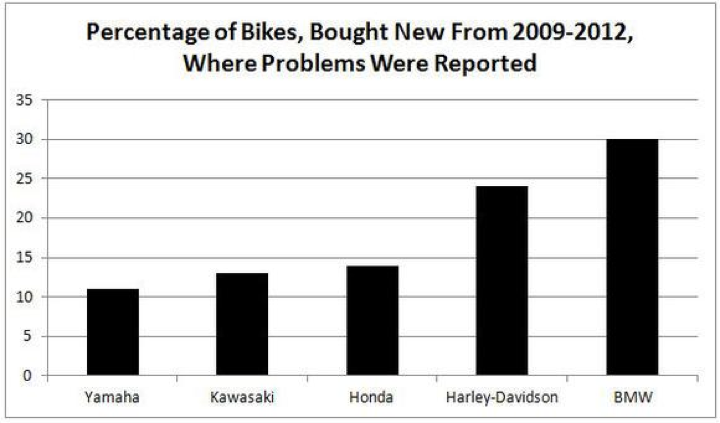
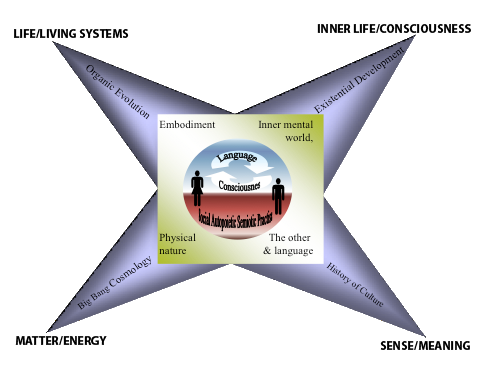
Figure 1 - Brier's STAR Model of Cybersemiotics
Søren Brier's (2013: 213) cybersemiotic star model posits four forms of communication: 1. The cosmological, 2. The biological evolutionary, 3. The socialhistorical, and 4. The personal-subjective.
Søren Brier is a Charles Sanders Peirce scholar who combines Peirce semiotics with Ed Luhmann cybernetics, to build a relational process ontology and epistemic framework of sociomateriality. Brier is editor of the journal Cybernetics and Human Knowing.
Organization systems, for Soren Brier is theorized in his model of the Cybersemiotic Star (Brier, 2013). Storytelling occurs in the four areas: Life/Living Systems, Inner Life/Consciousness, Sense/Meaning, and Matter/Energy. He builds his relational process ontology on work of the American Pragmatist, Charles Sanders Peirce, and on systems theorist, Niklas Luhmann.
The observing system in the middle of the Star Model captures and collapses the waves of possibilities into actual events. The Star Model represents the ontology, or the way of Being of an organization. In Star Model, each organization recreates itself in response to the waves of the four domains (1. Matter/Energy, 2. Life/Living System, 3. Inner Life/Consciousness, and 4. Sense/Meaning of the Social). Brier says, “I believe that we should ground our culture(s) on embodied human living (personal as well as interpersonal), i.e. on semiotic intelligence as part of both living nature and human culture, rather than only on the physical science and the worldview behind it” (Brier, 2013: 222). This has an as yet unexplored link to Follett, in that Follett was in the ‘Cambridge Intellectual’ group that included Peirce as well as Dewey, James. Follett's later work is therefore influenced by Peirce, but comes before that of Luhmann. Follett does have an original systems notion of self-organizing, co-power, and conflict integrative differences that has yet to be integrated in RPO. Brier, by contrast, develops a cybersemiotic dialectics out of Peirce’s philosophy, and combines it with Luhmann’s autopoietic typology of cybernetic systems. autopoietic is defined as a system capable of reproducing and maintaining itself.
PART I CHARLES SANDERS PEIRCE TRIADIC METHOD OF SEMIOTICS
Charles Sanders Peirce, an American Pragmatist philosophy (along with John Dewey, William James, and others, see Boje, 2014 for more), who builds upon Hegel’s triadic, producing many more triads of his own.
Peirce, like Bhaskar, is not limited to the empirics of sensemaking, nor to the actual object beyond sensemaking in eventness. Both venture into the real, and retain a spiritual vitalism, that Barad, Marx, Deleuze, and others shun. Similar to Deleuze, Peirce had a focus on differences in repetition, in the infinite differences (infinitesimal differences between), and in fallibility (an abductive proposition can be wrong and needs to be falsified and verified). Peirce goes beyond the dualism of Hegelian dialectic, in extending the negation of the negation, into the Triadic. We begin with FIRSTNESS, SECONDNESS, and THIRDNESS, and extend it into several other triadics.
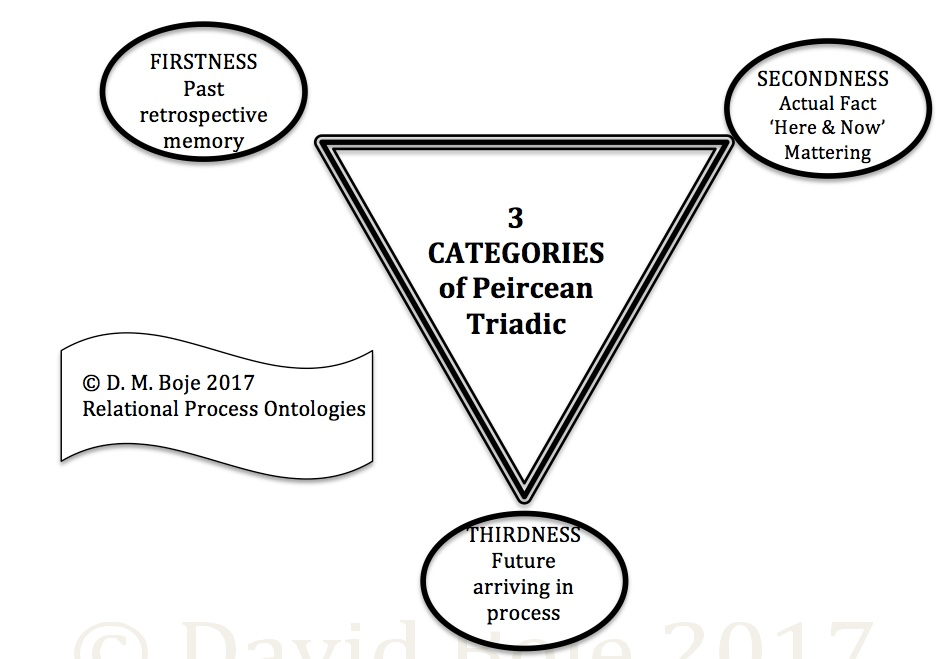
Figure 2: Peircean Relational Process Ontology (figure © D. M. Boje, 23 Sep 2017)
Charles Sanders Peirce attempts to improve Hegel's dialectic by putting three categories he reads imperfectly notioned in Hegel into relationship. The three categories are fashioned into a triadic relational process ontology. Peirce theorizes many triadics, of which Firstness, Secondness, Thirdness is the starting point for other triadics we will get to (such as Sign-Object-Interpretant, Icon-Index-Symbol, and Tychism-Anaancastic-Agapastic, the later of which is keenly important in Brier's work of cybersemiotics). In this rendition of Firstness-Secondness-Thirdness, I will accent Empirical-Actual-Real to form a connection to Roy Bhaskar's ontology, where the Empirical is less than Actual, and both less than Real (E < A < R).
Firstness is the 'empirical' and extends Hegel's sensory empiric category, what Weick (1995) calls the empirics of retrospective sensemaking, what we can touch, see, taste, smell and here in our experiencing consciousness that is in memory. To Peirce this is nominalism (no universals in real, and objects are socially constructed consciousness).
Secondness is the 'actual' object independent to what consciousness perceives in sensory consciousness, and in thing-to-thing of accomplished substantive relations in the 'here and now', the present happening events that are actual fact, embodied and instantiating, and action appearances that are mattering, substantive, and not limited to the singular sensemaker consciousness.
Thirdness is the 'real' (or 'realism') of future events arriving that cannot be experienced empirically or actually yet are the Laws of Nature, antecedent and consequent in a future tense of an endless future of broadest generalization.
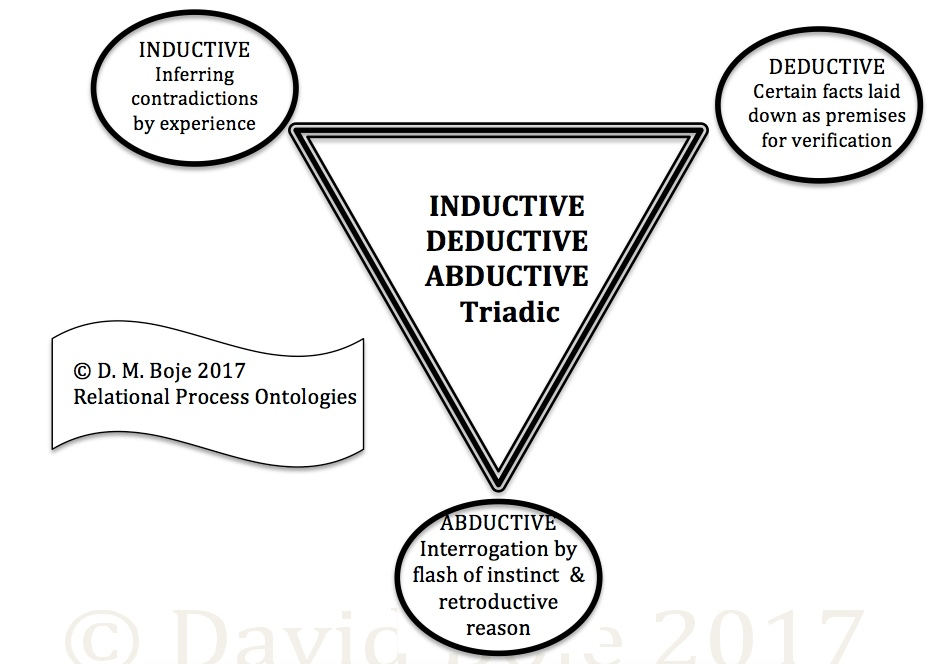
Figure 3: Inductive-Deductive-Abductive inference triadic (figure © D. M. Boje, 23 Sep 2017)
Peirce posits three kinds of inference, in relation to one another. Inductive inferences start and end with sensemaking (5 empiric senses) fashioning a proposition. The problem is the inductive inference can lack verification or falsification interrogation. Deductive inference puts propositions to the test in the actual, in spacetime. Abduction makes an entirely different move and is based on altogether different principles form induction and deduction. Peirce abductive inference provides an import relational process ontology to moves us into 4th Wave Grounded Theory. 1st Wave is mired in the fallacy of induction, 2nd Wave in the fallacy of deductive positivism, and 3rd Wave in the relativistic modes of social constructivism. 4th Wave Abductive inference attempts new principles.

Figure 4: Black Swan Hypothesis took a long time to emerge because of a strong Habit of believing 'All Swans are White" as a Major Premise
| DEDUCTION | INDUCTION | ABDUCTION |
|---|---|---|
| All Swans are White (PREMISE) | This Bird is a Swan (CASE) | All Swans are White (PRIMISE) |
| This Bird is a Swan (CASE) | Therefore, This Bird is a White Swan (CONCLUSION) | Therefore, This Bird is a White Swan (CONCLUSION) |
| Therefore, This Bird is a White Swan (CONCLUSION) | All Swans are White (PRIMISE) | This Bird is a Swan (CASE) |
FIRSTNESS INDUCTIVE INFERENCE - Peirce wants to subject induction to testing of an induction, verification, and falsification by experiment to have confidence in an inductive hypothesis. The problem with induction is it jumps from CASE to CONCLUSION (generalization) without gathering the samples widely enough to find BLACK SWAN. This is the most fundamental problem with the first three waves of Grounded Theory, just because a bird observed is a swan, does not mean the generalization 'therefore, this Bird is a White Swan, is a valid and reliable conclusion. Nor does doing social constructivism help, because just because all of Europe believes only white swans exist, does not make it so, in Australia.
"The operation of testing a hypothesis by experiment, which consists in remarking that, if it is true, observations made under certain conditions ought to have certain results, and then causing those conditions to be fulfilled, and noting the results, and, if they are favourable, extending a certain confidence to the hyposhtesis, I call induction" (Peirce, Philosophical Writings of Peirce edited by Justus Buchler, 1955: 152).
He wants sampling to verify an inductive hypothesis:
"All induction whatever may be regarded as the inference that throughout a whole class a ration will have about the same value that it has in a random sample of that class, provided the nature of the ration for which the sample is to be examined in specified (or virtually spectivied) in advance of the examination" (Peirce, Philosophical Writings of Peirce edited by Justus Buchler, 1955: 152).
SECONDNESS DEUCTIVE INFERENCE - Peirce's idea is the deduction attemps to predict some thing in the population from a sample. However, since the 'real' is more than the 'actual' eventness, and certain general laws are not always in the eventness, the truth or falsitity of deductive propositions is still fallible. The problem with the White Swan Deduction (hypothesis) is that the major premise (All swans are white, is flawed). The major premise had become a habitual thought (stereotype), and Europeans and Americans, were blind to Black Swan Hypothesis.
THIRDNESS ABDUCTIVE INFERENCE - Peirce contends that there is a certain element of guess-work in induction, that he terms "abductive induction" (Peirce, Philosophical Writings of Peirce edited by Justus Buchler, 1955: 152). The BlackSswan Hypothesisinvestigation did not exist, because in all of Europe, all counts of swans, only found white ones. The Doctrine of Fallibilism, was not beeing tested or verified. In Australia, Balck swans did exist. It is a huge problem when common sense form one continent is applied to another continent. The White Swn Hypothesis needed to challenge its major premise with more "abductive inference" (p. 304) to shade the judgement made by both DEDUCTION and INDUCTION inferences.
What Peirce attempts and succeeds at doing is to make the guesswork more robust. Abductive influence can be strengthened by our experience with a given organizational system relations and processes, its situation. "It is remarked that, in pure abduction, it can never be justifable toa ccpt the hypothesis otherwise than as an interrogation. But as long as that condition is observed, no positive falsity is to be freared; and therefore the whole question of what one out of a number of possible hypotheses ought to be entertained becomes purely a question of economy" (Peirce, Philosophical Writings of Peirce edited by Justus Buchler, 1955: 154). Abdcution calls for vigorous powers of retroductive reasoning in conjunction with an "animal instinct" "best guess" in "light of nature" and its "evolutionary process" in relaiton to cosmos (Roth, 1988: 132-133). As Roth contends, the human mind is part of evolution and emerged in the process of reasonableness, and is "attuned to the truth of things" in Nature (p. 134). This has the ring of Heidegger (1962) attunement vibrations of the body Being-in-the-world, and Barad's inseparability of human from Nature, in posthumanist sociomaterialism. Part of the rigor of adbuctive interrogation of any flash of instinctive insight, is Peirce's principle of continuity, to make each new fact that changes an old opinion, a minum jolt, to choose among auxillary hypotheses, one least radical to continuity. Make a smooth and least jolt transition to the new flash of revelation, but icubation in a series of interactions onece the abductive inference is put forth. Peirce's Lasw of Nature unlucks Hegel, and "the arcana of philosophy" of both physics and matematics (Sbndoni-Mertzou, 1997: 66). Keep in mind Peirce is critical of inductive method because of its nominalism, its failure to go beyond the singlular sisensemaking into the actualal, and critial of deductive for limiting itself to here and now eventness, without testing inferences into the 'real.' Sensemaking empiricism is anti-ralist (nominolitic) in the calim every actual occurance, in their numerous repeitions is additive of single sensemakors perception. Peirce Lwas of Nature extend to the future events that are not net experienced in the actual, factness level of there and now appearances. The Laws of Nature allow adbudivice and retroductive reasoning to combine to go beyond accomplished facts into boradest generalization in an interrogation of evolutionary ebb and flow, and int the potentiality as yet unmaterialized. Peirce semoitics next move is triadics of Sign-Object-Interpretant.
Brier (2013: 248) asserts "We use signs to create life worlds or Umwelten as much as we use them to create models of ourselves." Each sign is "a living thing" (Peirce, as cited in Brier, IBID).
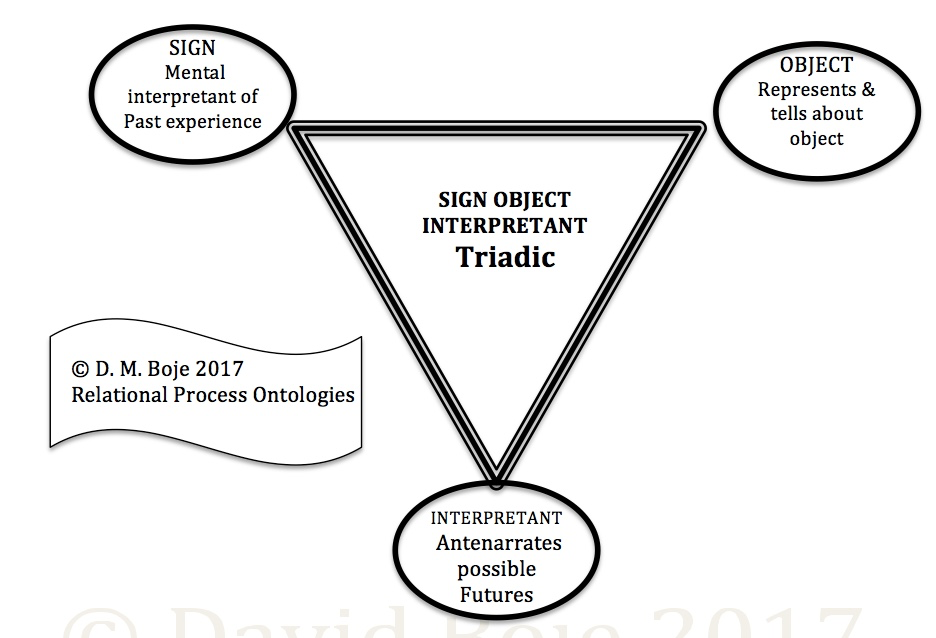
Figure 5: Sign-Object-Interpretant Triadic (figure original © D. M. Boje, 2017)
FIRSTNESS SIGN - sign (or representanem) is a mental interpretant of past experience.
SECONDNESS OBJECT - object of sign represent by telling about it, in the here and now. Here and now are cycles, the recur, without attention to differences, in this now from the last one, or antenarrative anticipation of bets on the future, that the next cycle will not differ, or move into difference with its last manifestation in the struggle of cycle and its resistance.
THIRDNESS INTERPRETANT - what Boje (2014) calls antenarrative expectancy of possible futures, arriving. One example is the spiral that has expanding or contracting alternating whorls. Potentiality is futural, becuase the future is imparting a quality of difference to the sameness. You cannot define a spiral dyadically (in interrogating Self-Other, Secondness), or singlarly (in sensemaking Firstness). It takes Thirdness to specify the relaitonal process ontology of spiral. If a spairal ahs and East and West and Upward movement, this triadic is necessary to specify its moving right and left in roatation of its mattering substance (Peirce, Philosophical Writings of Peirce edited by Justus Buchler, 1955: 92). Thirdness is the synthesis move of traidic processes of THirdness.
"The cateogry of first can be precinded from second and third and second can be prescindedfrom third. But second cannot be precinded from first nor third from second" (Peirce, Philosophical Writings of Peirce edited by Justus Buchler, 1955: 97).
![]()
Figure 6: Icon-Index-Symbol triadic (figure original © D. M. Boje 2017)
FIRSTNESS ICON - the sign possesses charact (functions) until it actually determines an Interpretant, yet that character-quality is not dependent upon its ever actaully having an object (secondness), as it can just be past memory, iconicized.
SECONDNESS INDEX - a sign (or representation) that refers to its object bot by analogy by including spatial and/or temporal connection, and may refer to existent things (here and now), by indices (indexicals). By extension, in a Baradian sense the indexicals are performing agential cuts in spacetimemattering.
THIRDNESS SYMBOL - a sign that becomes a rule (or law) of the universal. Symbol is Being a rule that will determine its Interpretant (Peirce, Philosophical Writings of Peirce edited by Justus Buchler, 1955: 102). All words, sentences, books and other systems of text, are Symbols Storytelling is an embodiment of the word, spoken, written, or theatrically enacted, and attached with antenarrative-meaning of the possible futures.
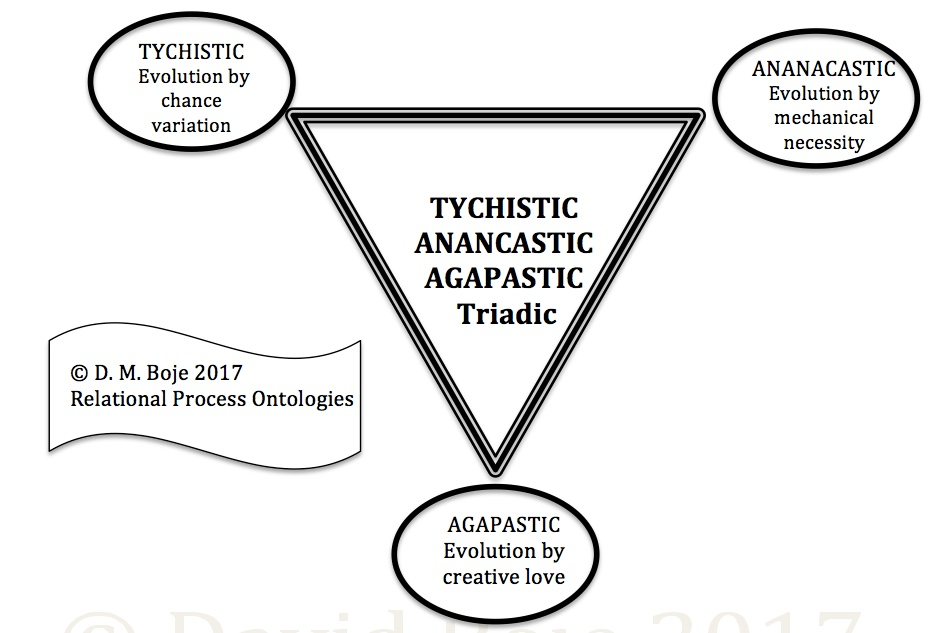
Figure 7: Tychistic-Anancastic-Agapastic THREE MODES OF EVOLUTION triadic (figure original © D. M. Boje 2017)
Peirce entangles three entangled modes of evolution. Note Peirce extension to Hegel, is the human mind/body/spirit are in an evolutionary development in a triadic.
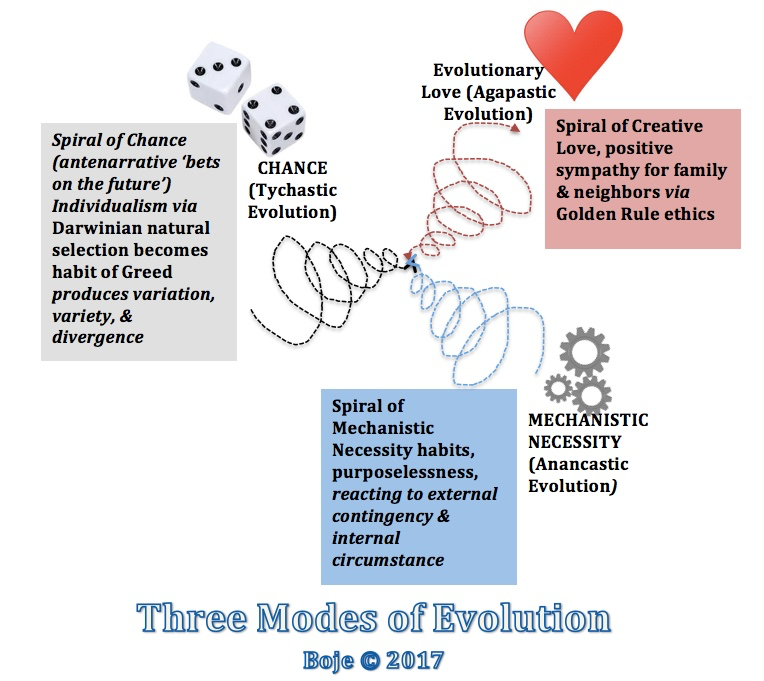
Figure 8: Three Spirals of Evolution (Boje's rendition of Peircian Tychistic, Anancastic, & Agapastic evolutions © Boje 2017)
The scientist is using insight and inference in an animal instinct to use adbuctive gesses, flashes of insight that come from human embeddedness in three evolutionary modes of Being. Abduction inference is working itself out, grounding inthe three modes of evolution, so people are Naturally but imperfectly "attuned to the truth of things" (Peirce as cited in Roth, 1988:134). Like Hegel, Peirce contended that it was evolution that gave humans some control over the induction process, grounded it in continuity (a main concept in Peircian Laws of nature, thirdness). John Dewey also considered the flash of revoltion and its incubation a way to develop indicutiv logic.
FIRSTNESS TYCHISTIC - Evolution by chance combinations are biological forces resulting in fortitidous variation and multiplicity. Makes a move of sensemaking and leaves inductive inference propositions in their multiplicity, on the table, for the next players to negate.
SECONDNESS ANANCASTIC - Evolution by mechanical necessity. Moves to object level in instantiation and embodiment. Has parallels with Hegelian philosophy (Ryan, 1988: 365), of the unfolding ebbs and flows, the pahses of mattering developing of a process, in what Barad (2007) terms spacetimemattering.
THIRDNESS AGAPASTIC - Evolution by creative love, reproductive creation. Peirce, saw in Hegel, a wekkly Notion of spiritual Love, an energy, the breath of love of the vital spirt, drawing Being into harmon by attention to the procesesses, caring for their development.
PART 2: IMPLICATIONS OF INFINITESIMALS FOR ANTENARRATIVE THEORY
Peirce theory of infinitesimals is the counting or ordering infinitely small quantities actually exists in experience is the same as infinitesimals existence in mathematics, such as “differential calculus reproducing multiplicative inverses of infinite quantities acting as infinitesimals” (Herron, 1997: 594). In other words, the possibility that continuities of infinitesimal differences in small numbers does actually exist in the material world of both mind and matter. Peirce held that we need a theory of infinitesimals to explain our human understanding of the passage of time and how our ideas are associated to one another by their similarity and contiguity (proximity and succession of overlapping ideas) in our consciousness. The implications for storytelling in action is that “consciousness is aware withn an infinitesimal interval of time, called a moment, consisting of infinitesimals pieces of the nearby past and future along with the current point-instant; and asserts that successive ideas can overlap within moments” (Herron, 1997: 595). The infiinitesimal interval is important to the storytelling problem of sensemaking the now and ‘now+ξ’ storied at the same time in transitive relation of ideas in a sequence of instants inside that interval. For Peirce, “space is also continuous because space is the range of possible positions of continuous physical objects (which are not fully determined, though more so than mental objects)” (Herron, 1997: 595).
This is an inductive problem for which mathematical induction of our storytelling of the continuity of spacetime is more fruitful propositions than guessing how spacetime has discrete localities/instants or that matter is discrete (discontinuous & separate). Physical matter, however is more fully determined, for Peirce’ than mental substances (or mental objects, mental distances) of spacetime. Spacetimemattering (in Baradian terms), read through Peirce’s pragmatism theory of continuity of infinitesimals becomes important to storytelling in action.
Pierce’s principle of continuity entangles infinitesimals with fallibilism doctrine that human knowledge is in a an continuum of uncertainty that is in dialectical opposition to nominalism (universal ideas correspond to reality):
“The principle of continuity is the idea of fallibilism objectified. For fallibilism is the doctrine that our knowledge is never absolute but always swims, as it were, in a continuum of uncertainty and indeterminacy. Now the doctrine of continuity is that all things so swim in continua. … For where there is continuity, the exact ascertainment of real quantities is too obviously impossible: The Collected Papers of C. S. Peirce 1931-1958, Vol. 1 170-175 as cited in Herron, 1997: 596).
Continuity for Peirce’s is his best example of Thirdness (relation to law as indeterminacy as spacetime for major changes in the potentiality of the world by the three modes of evolution of spontaneous deviations from laws). “Continua, like time and space, consist of very general possibilities which become less general as the universe evolves” (Herron, 1997: 597). Bounded rationality, in the discipline of organizational systems, is a theory of limiting approximations, that for Peirce, is too conservative philosophically, to understand our concrete experience, for it would disallow infinitesimals of spacetimemattering. Can we develop the theory of infinitesimals instead of reducing storytelling to the doctrine of bounded rationality (or limits doctrine)? Are there deficiencies in the doctrine of bounded rationality? Certainly a Baradian quantum understanding of spacetimemattering iterative re-configuring needs to get beyond the reductionism of bounded rationality.
Are there distinct uncountable cardinals (ζ) possible in a continua set (0, ζ, 1, 2, ζ, 3, . . .)? Each ζ is capable of being assigned a multitude of distinguishable qualities (properties of individuality). Are their unique ζ living stories in the web (or set) of living stories, in continua of spacetimemattering? This ζ-living story, and ζ-antenarrative among the cardinal narratives constitutes an antifoundationalist idea of storytelling organization or continuum of storytelling assemblage. The ζ-potentiality can contribute to our understanding of how parts and wholes relate in organizational storytelling systems. The standard model of narrative and counternarrative, is that no meaningful differences exist, such as ζ-living stories webs that are without beginning-middle-end coherence, or ζ-antenarrative processes before-narrative, beneath-narrative, between-narrative-and-counternarrative, or bets on potential futures untied to the continua of past-nows. If ζ is an inseparability of spacetimemattering, then time continua are entangled with space and mattering continua. Between any two ζ is yet another ζ, making narrative coherence always subject indeterminacy. There is always another ζ-antenarrative side, another ζ-infinitesimal, or ζ-magnitude to storytelling relational process ontology, it continuity and multiplicity. Applying Peircean theory, there are gaps in the storytelling continuum, infinitesimal distances in spacetimemattering of the storytelling.
Thought experiment about Storytelling ζ-Thirdness. Assume a agential cutting knife with a blade so thin it can make an agential cut just before, or just in-between, or just after, a narrative to isolate particular ζ-antenarratives. Can the storytelling wholeness have an agential cut, into two completely symmetric parts? If a continuity of storytelling does not consist only of linear assemblage, and instead has multiplicity, the ζ-discontinuity cusps are possible, embedded in the storytelling ontology. Narrative keeps attempting to squash differences, erasing ζ-living story web work, ζ-infinitesimals, and ζ-antenarrative processes that do not fit. The ζ-antenarrative process keeps emerging more silenced-differences in the untold stories (Hitchin, 2014). There is a multitude of ζ-untold stories between the narrative and counter-narrative agential cut. This multitude of ζ-antenarratives between, beneath, before, bets of narrative and counternarrative is dialectical, pragmatically different content untold in both narrative and counternarrative. That makes ζ-antenarrative the Thirdness to the Firstness of narrative and the Secondness of counternarrative.
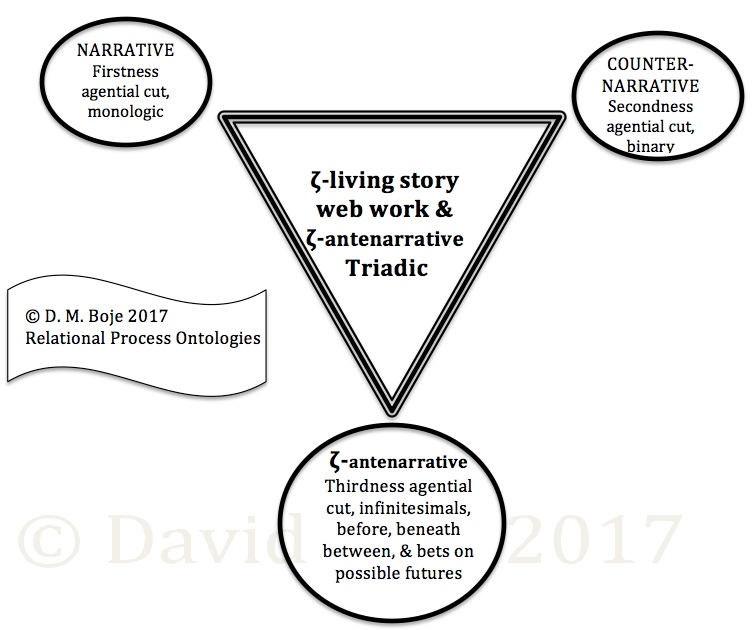
Figure 9: ζ-antenarrative Thirdness cusps of difference, infinitesimal, and disruption to narrative Firstness, and Secondness-counternarrative (figure original © D. M. Boje 2017)
The cardinality of narrative Firstness and Secondness is opposed dialectically by the uncountable-Thirdness-cardinality of ζ-antenarrative cusps of difference, contradictions untold, as yet, potentially emergent in nextness of storytelling. Storytelling, therefore, does not just come with narrative-reasoning, it also contains other types of possible reasoning, such as ζ-living story webs, and ζ-antenarrative processes in the continua of storytelling.
There are now many path-breaking attempts to find antenarratives and isolate living story webs that do not conform to Western narrative (counternarrative) reasoning and logic. Peircean theory of fallibilism and infinitesimals makes a contribution to Baradian agential cut and to ways distinct ζ-antenarratives merge together with as well as disrupt organizational storytelling systems. The narrative problem is that narrative-ordering governance over all storytelling continua overlooks ζ-relational process ontologies. Similarly, whole systems can have infinitesimal ζ-antenarrative processes and ζ-gaps in the narrative-ordering of storytelling. There are always more levels of exactness in storytelling, in infinitesimally smaller qualities of spacetimemattering ζ–antenarrative neighborhoods around, before, between, and bets on futures, unspecified or ignored in narrative and counternarrative. Narrative-counternarrative has relatives, ζ-living story and ζ-antenarrative process neighborhoods that the doctrine of bounded rationality would subject to narrative-renewal. The ζ-antenarrative and ζ-living story web work infinitesimals should be accepted as real, beyond the empirical and the actual (see Bhaskar chapter), in what Peirce calls Thirdness.
Induction and deduction alone or together, cannot be used to prove true storytelling, without inclusion of the ζ-community of abduction that tells the ‘real’ part of the organizational storytelling system, including the existence of ζ-antenarrative relational processes. There is a continuum of ζ-infinitesimals in-between, before, beneath, and bets of futures after narrative-counternarrative dualities. Narrative-counternarrative binary is one kind of agential but, but other kinds of agential cuts, include ζ-living story web work and ζ-antenarrative process, neighborhoods of spacetimemattering.
Next we turn to Brier's other partner, in his cybersemiotics theory, Edmund Luhmann
PART 3: Edmund Luhmann triple autopoiesis model, where both the biologic and psychic systems are silent and only the socio-communicative autopoietic system can communicate
Autopoiesis (from Greek: auto, “self”; and poiesis, production) is a self-regenerating relational network process (Varela, Maturana, & Uribe, 1974). Søren Brier (2013: 229, bracketed addition, mine) asserts that "Peirce’s semiotics concords with Luhmann’s system theory, Popper’s critical rationalism [critical realism] and Bhaskar’s critical realism in that it sees humans as able to create knowledge together in a synergy of language and praxis." There are three autopoiesis relational processes: psychical (or psychological) autopoiesis, socio-communicative autopoiesis, and biophysical autopoiesis.
Accoding to Brier (2013: 228-229):
"Luhmann (1990) proposes a triple autopoiesis model, where both the biologic and psychic systems are silent and only the socio-communicative autopoietic system can communicate. Biological autopoiesis functions in the medium of life whereas psychic autopoiesis and the socio-communicative autopoiesis both function in the medium of meaning. Thus communication consists of autopoietic systems. "
Brier (2013: 235): "Luhmann (1995) proposes a triple autopoiesis model consisting of three systems: the biological and psychic systems, which are silent, and the ‘sociocommunicative’ system, which is the only one that can communicate." Each autopoitic system continuously produces and regenerates its relational process network.
Søren Brier (2013: 235): "Luhmann (1995) proposes a triple autopoiesis model consisting of three systems: the biological and psychic systems, which are silent, and the ‘sociocommunicative’ system, which is the only one that can communicate." Each autopoietic system continuously produces and regenerates its relational process network.
“Luhmann tried to solve the problem of qualia and first person consciousness, and its involvement in communication and language, by introducing an understanding of the psyche and the socio-communicative system as autopoietic systems” http://www.iupui.edu/~arisbe/menu/library/aboutcsp/brier/2_Brier_v1_2.pdf
Søren Brier assumes that only the socio-communicative autopoiesis is communicative. This contradicts Karen Barad agential realism in which biological spacetimemattering is intra-active with discourse, and Roy Bhaskar's critical realism in which in stratified open systems there are interactive levels of reality encompassing the empirical and the actual. I will argue it limits Charles Sanders Peirce's theory of infinitesimals.
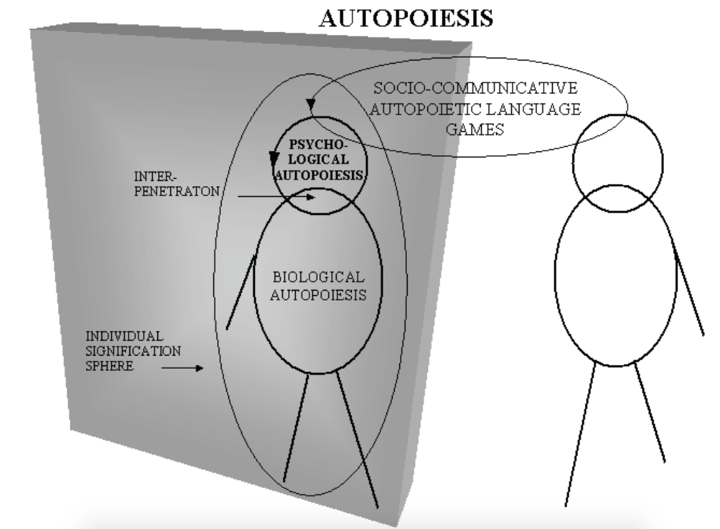
Figure 10: Brier's (2013: 246) model of Triple Autopoiesis
"Three organizationally closed systems working separately make communication possible. This figure is a symbolic iconic picture of Luhmann’s basic theory and not a map of where the various systems are placed in the body" (Brier, 2013: 246, italics, original).
Søren Brier assumes that only the socio-communicative autopoiesis is communicative. This contradicts Karen Barad agential realism in which biological spacetimemattering is intra-active with disourse, and Roy Bhaskar's critical realism in which in stratified open systems there are interactive levels of reality encompassing the empirical and the actual. I will argue it limits Charles Sanders Peirce's theory of infinitesimals.
HOW DOES CHARLES SENDERS PEIRCE APPROACH THE QUESTION OF QUALITY?
Peirce’s semiotic is about “another series of elements imperfectly represented by Hegel’s Categories” in his dialectical development philosophy (Peirce, 1904, Philosophical Writings of Peirce, p. 75).
Peirce’s proposed method (pragmatism semiotics) relies on observation and experiment but avoids “hypothetical explanations of any sort” by scrutinizing direct appearance with minute accuracy in broadest generalization (p. 75).
These three ontological modes of Being
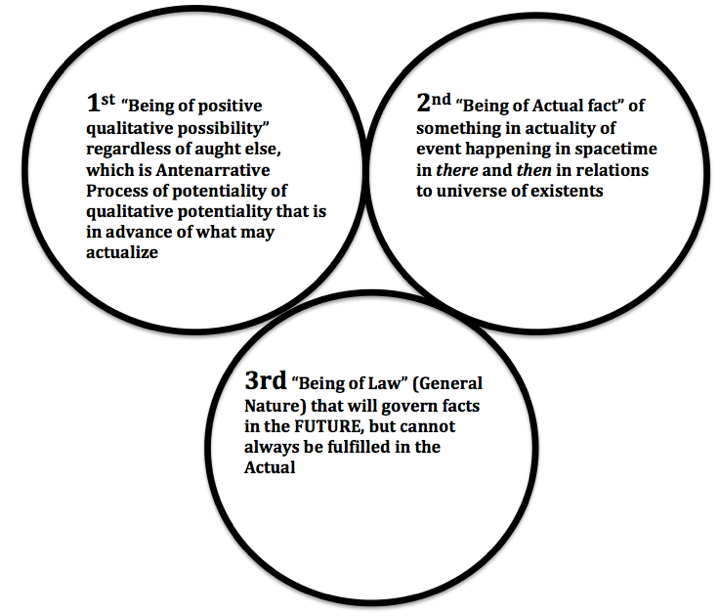
Figure 11: TRIADIC ONTOLOGY of Firstness, Secondness, and Thirdness (figure original © D. M. Boje 2017)
FIRSTNESS – Being of positive qualitative possibility, in the possibility of quality of things and services is for me an antenarrative potentiality of a relation that may or may not actualize. Antenarratively I can be forecaring in advance to increase the odds of quality actualizing.
SECONDNESS – The sense of actuality, its facticity as Heidegger (1962) calls it, is for Peirce (p. 76), ‘brute” in the “pure sense of actuality” in “a mode of being of one thint which consists of how the second object is.”
THIRDNESS – I can predict quality and the majority of my predictions are fulfilled in actual event, but that prediction of the general nature of quality cannot ever be completely fulfilled. Rather it’s a roll of the dice that future events will conform in happening of actualized “future facts”(p. 77).
The ζ-living story and ζ-antenarrative process neighborhoods need to be given autopoiesis communicative agency and expression. As William James (1907) puts it, 'things tell stories.' We may therfore consider an alternative interpretaiton of Brier's cybersemiotics, in thich ζ-living story and ζ-antenarrative process neighborhoods are meaningful communicative expression with fallibility and infenitesimal Thirdness.
If as Bhaskar contends, Empirical < Actual < Real, or E < A < R, then I propose this axiom: ζ-living story and ζ-antenarrative process neighborhoods swim amongst R and are indectable in E retrospective narrative (counternarrative) sensemaking and A ordinality, yet form overlap with narrative-counternarrative.
8 Principles of TQM Organizational System
- Customer Focus (customer as center of attention)
- Leadership (unity in organizational direction with common goal)
- Total participation Involvement of all people (of 1 & 2)
- Process Approach
- Strategic Approach to Management (in Plan & Doing it Right every time)
- Culture of Continuous Improvement (Kaizen)
- Decisions based on Factual Approach
- Mutually Beneficial Supplier Relationships
There are differences in storytelling systems between narrative, counternarrative, and uncountable ζ-living story and ζ-antenarrative process neighborhoods. The Law of the Excluded Middle does not hold for Thirdness of ζ-living story and ζ-antenarrative process neighborhoods. In organziational storytelling narrative, counternarrative and ζ-living story and ζ-antenarrative process neighborhoods, merge together so they are no longer distinct elements of storytelling, and the Law of Contradictions (or Excluded Middle) [Lane, 1997; Herron, 1997] assembles storytelling in triadic infinitesimal intervals and gaps, the betweenness of parts and wholes.
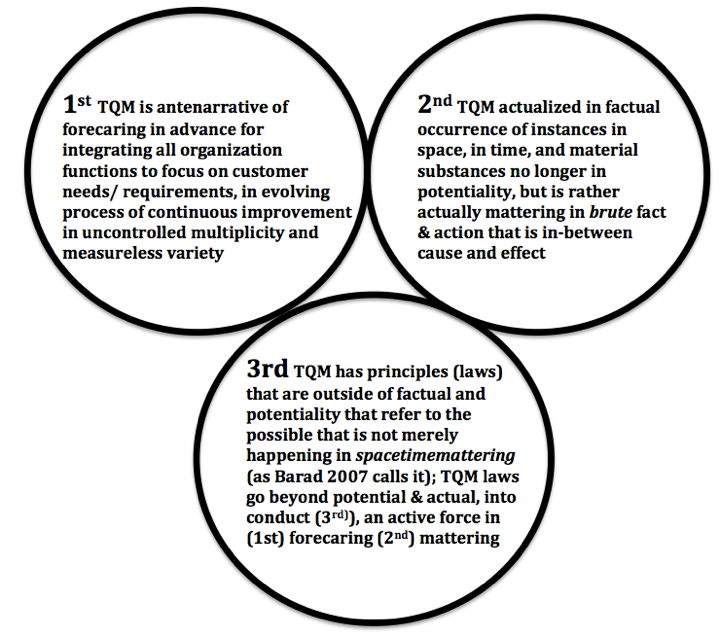
Figure 12: Integration of Peirce Triadic Ontologies with TQM (figure original © D. M. Boje 2017)
Firstness is freedom of antenarrative is unlimited in the uncontrolled variety and multiplicity of Firstness (Peirce, p. 79). Antecedents to of forecaring are preparations in advance. Firstness is not sensemaking, not the retrospection of memory (narratives or counternarratives).
Secondness is a force in-between cause and effect, in space, and the flow of time, and in mattering, what I call living story webs of actualization and instantiation. There is reaction between the ‘ego’ of those involved in TQM and the ‘non-ego’ of direct consciousness that we are agents of the organization, playing our roles.
Thirdness is the laws of TQM, its universal principles, which are outside of actualization and forecaring. At the same time, TQM laws are an active force in 1st and 2nd. Rather than sensemaking or retrospective memory, the future acts upon the past through the medium of thirds. Laws hold sway in Nature
Peirce (p. 84) asks, “What, then, is a quality?” It is not anything dependent upon TQM being of mind, nor is it dependent on being fact of some material thing possessing it. Quality is also not dependent upon sense or sensemaking. That would be a great error because “a quality is a mere abstract potentiality” and “qualities exist without actually being perceived” (p. 85). “A sense-quality is only a possibility of sensation … but no sensation nor sense-faculty is requisite for the possibility which is the being of the quality” (p. 86).
Lane (1997: 680), "Charles Pierce makes ... claims about the ;principle of excluded middle' and the 'principle of contradictions' ... Pierce offers the proposition 'A man whom I could mention seems to be a little conceited'" is both true and false, bcause both principles (middle & contradiction) fail to be determinate. Narrative seems to be a little conceited, claiming all storytelling is narrative or counter-narrative. Such a claim leaves in vagueness, ζ-living story web work, and ζ-antenarrative relational process, neighborhoods of spacetimemattering. The negation of narrative-counternarrative storytelling claim, neither true nor false, since it is Thirdness that is in relationship to Firstness (narrative) and Secondness (counternarrative)
"Peirce characterizes object-indeterminancy in terms of the lattitude of interpretation extended to either the utterer or the interpreter of an object-indeterminate proposition" (Lane, 1997: 683).
So the general proposition that all storytelling is narrative-counternarrative, and none other, reduces interpretation by claiming excluded middle and law of contradiction. The narrative is all of storytelling seems hard to accept at face value, because storytelling can involve a little or much narrative-counternarrative, and not encompass the ζ-antenarrative in-betweenness, beneathness, beforeness, and bets of possible futures, nor the ζ-living story web work that keeps extending.
Organizational storytelling assemblage (✪), is consetllated, such that ✪={narrative, counternarrative, ζ-living story web work, and ζ-antenarrative relational process, neighborhoods of spacetimemattering}. My argument is storytelling is the aggregate ✪, and is more than narrative-counternarrative (Firstness-Secondness) and our organiational research inquiry must include the Thirdness ζ-elements of living story web and antenarrative process.
PART 4 - ANTENARRATIVE SPIRALS AND CYBERSEMIOTIC THEORY
Charles Sanders Peirce's theory of natural classes makes an important link between efficient casation and final causation.
"Efficient causation is that knod of causation whereby the parts compose the whole; final causation is that kind of causation whereby the whole calls out its parts" (Peirce, 1931-1935, Vol. 1: paragraph 220, original, 1902, as cited in Hulswit, 1997: 744).
Here, I well create a Peircean theory of spiral, in which final cause agency conferring whole system teleogical-shape, and calling forth the efficent cause agency of motion and change to starting and stopping. Spiral is a system made up of efficient parts and called forth into system-wholeness by final cause.
Hulswit (1997: 749) puts Peierce's changes to his conception of natural classes into historical context. In 1866 Peirce contended that natural slasses have three characteristics: (a) an initial, dinfining character (D) of the class , (b) characters must by logically implied by its definition, and (c) the class must include one or more empirical character. In 1901, Peirce revised his conception of natural class, as (a) an initial defining-character (D), and (b) a permanent relevent empirical (PRE) character. In 1907, Peirce related natural class to final causation, in a move away from the 1866 epistimic-conception toward a metaphysical telelogical causal conception where PRE was no longer necessary. By 1908, Peirce distinguisted between 'natuural class' versus the 'nautral kind', whose elemetns do not exist Being-in-the-world (to use Heideggerian terms). In 'natural kind' we can have an idea of, for example, a spiral, but for natural class, the specieis spiral must be embodied and instantiated, existentially Being-in-the-world.

Figure 13: Final and Efficiaent Causations of Spiral from Natural Kind to Natural Class (figure original © D. M. Boje 2017)
The difference between natural kind (idea of a spiral) and natural class (spiral species in existence) and the way Peirce incorporates efficient causes in system processes (parts) while the final causation (whole) system is called out of its parts, is key to developing spiral causation theory. The spiral as a "single animating purpose" to become whole system (Perice, Volume 7, paragraph 54, written 1902) as cited in Hulswit, 1997: 753). There are natural kind spirals in nature (Boje, 2016; Henderson & Boje, 2016) and artifical spiarls in our socio-economic, socio-cultural, and sociomaterial systems.These spirals are researchable, such as merger spirals, economic death spirals of an organization's demise, conflict esclation spirals, violence spirals in larger inner cities, conviviality spirals, and so forth. The spiral form and structure is shaped according to final cause, and what is brought into relation are the efficent cause of events and facts, as both kinds of causation give tendency and energy to the whole spiral pattern.

Figure 14: Exploding phone battern onn planes
What are the autopoiesis parts of the spiral pattern?
Recall Brier (2013: 235) includes the biological and psychic (psychological) systems, which are silent, and the ‘sociocommunicative’ system, which is the only one that can communicate. I contend that the final cause is agential in a teleological communicative action, of calling forth, and is an animating final purpose. From a Baradian standpoint, the subatomic, quantumness of spacetimemattering is agentially real in the spiraling movements and rotations. The wave/particle collapse is by the intra-activity of materiality with discourse, not separable biological and psychological autopoiesis parts from the socio communicative autopoiesis component. As decision makers and observers collapse the wave, of many possible futures of the spiral, in its final cause purpose selection, one of the spiral potential patterns becomes the calling forth of a particular spiral formation pattern. As antenarrative bets are made on the alternative futures, one spiral system becomes invested with spacetimemattering energy, and the alternative spiral systems fall by the wayside.
For Peirce, writing before Baradian agential-realism, the defining character (D) of spiral and its final cause selection is done "independently of any context of inquiry" (Hulswit, 1997: 762). Baradians would be critical, since materiality is impacted by the boservational appartus of scientific inquiry and measurement. Measure for wave, adn you get wave. Measure for particles, and particles show up, and antecedently so, in the strangeness of quantum physics.
What Peirce adds to spiral theory is his notion of causal pluralism, the interaction of efficient cause with final cause. Baradians would certainly insist on material causation being included in the causal pluralism. In material causality, the medium of the material is important to spacetimemattering of the spiraling development, and whatever final causation is purposefully collapsed (Boje, 2014; Boje & Henderson, 2014; Boje & Henderson, 2016).
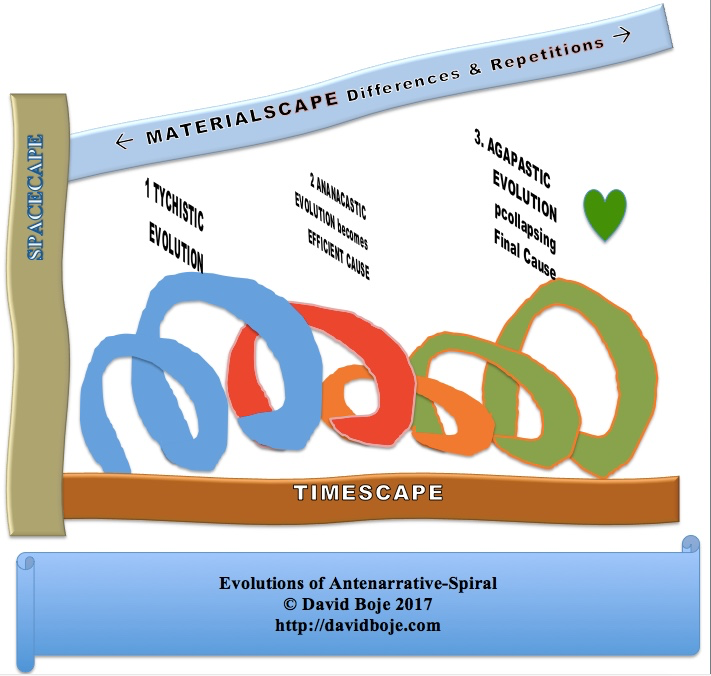
Figure 15: Spiraling with Final and Efficient Causation from Tychistic to Anancastic to Agapastic care (figure original © D. M. Boje 2017)
Spiraling is spacetimemattering movement. Each whorl of the spiral is its own particular sort of dialectc. Above three dialectic movements are depicted.
1.) Tychistic dialectic is an evolution of growth by novelty and chance of the idea-spiral (natural kind that is not yet and may never become natural class), and is resisted by an opposition of conservation of energy reining in the risktaking. It is diviation-amplifying growth attempts opposed by deviation-counteracting conservation at the outset of open system formation that is purposive but not well reasoned.
2.) Anancastic dialectic is evolution of systematizing of event-to-event that secures more efficient causation, embodied routinizing the instantiated attempts at controlled systemic growth opposed by the downside of routinization of efficient cause into phases in somewhat rigid repetitions. Efficent causes is always events and fact grounding but not very tied to an end or purpose. "Each evetn is part of a continuous chain of events" (Hulswit, 1997: 765). Members of the chain of events tend to behave according to their routines and habits, their habituation brings stability but not necissarially growth. Natural class is taking on a bit more foretelling, a selection of one spiral formation leaving the alternative futures uninvested in the selection of this efficent process over alternatives.
3.) Agapastic dialectic is foreordained growth upswing of creative spacetimemattering energy infusions opposed by conservations of other spacetimemattering energy drawn into the sprial system.
Continued spiral uplift and growth, despite the calling of final cause, its purposive instantiation and embodiment systemically. Above, in Red, the spiral has its downturn, and left unabited, will result in death spiral, and going out of esistence. As the story is told, in the Green zone, the uplift returns, and by love and care (agape) there can be fulfillment of the foresight, final causation can have it way. But, that is limited by the environment, the state of the socioeconomics, the rhythm of the sociomateriality. The foreordained spiral uplift may not come into Being. Final cause is tot totally determinate of spiral growth, and spiral decay an set int, the spiraling can become uninstantiated, and unembodied, and continued existce unlikely, the antenarrative bet on the future, unfulfilled.
The rhythm of the tychism dialectic makes some small bets on the future, but the effort is too unfocused, too insecure ventues. In the anancastic dialectic rhythm, the mechanized routinized system control of process to insure more exact recurrence sets in. This can create growth or suck the createive energy out of the system and its interpretation. In its agapastic dialectic rhythm, spiral can collect possiblility for uplift into a potential future, a final cause, is embodied, instantiated, but the scoioeconomic forces, and continuations of novelty, surprise, and chance can work against uplift.
PART 5: IMPLICATIONS OF THREE AUTOPOIESES FOR SANDTRAY EMBODIED RESTORYING PROCESS (ERP)
In this section I will develop Brierian insights into the embodied restorying process. My work in sandtray began with Anete Strand's material storytelling. Strand's (2012) dissertaiton works with Barad and my work on storytelling (narrative-living story-antenarrative). Strand' material storytelling sandtray work is grounded in Barad's agential-realism, intra-activity of materiality with discourses, and embodied re-configuring. I would like to take this in another direction, give it another layer of sandtray praxis in Luhmann's three autopoieses, crisscrossing them in the sandtray work with Peirce's triadic semiotics.
How can we integrate Peirce First, Second, & Third with Autopoiesis types of Edmund Luhmann?
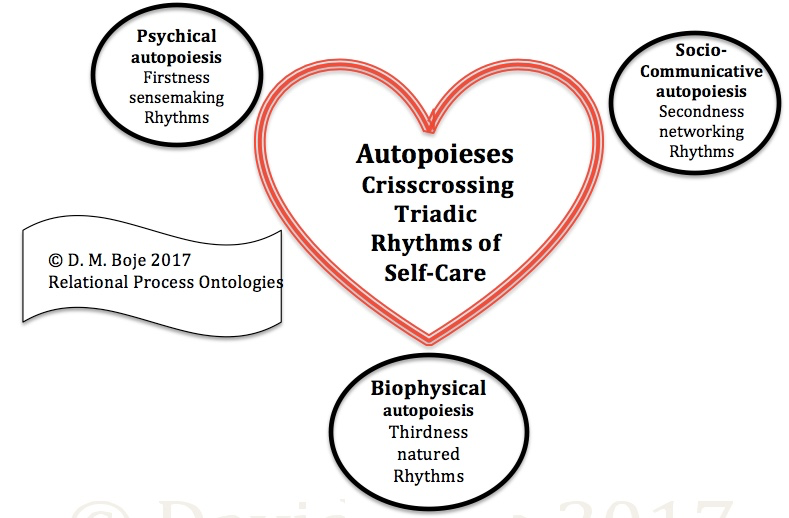
Figure 16: Autopoieses Crisscrossing Triadic Rhythms of Self-Care (figure original © D. M. Boje 2017)
My purpose is to bring the three autopoieses into quantum storytelling system. By this I mean that all three autopoieses: psychical (psycholgoical sensemaking), sociocommunicative, and biophysical autopoiesis --- are part of quantum storytelling system.
What was the first autopoiesis theory:
"It was in these circumstances ... in which he analyzed Don Quixote's dilemma of whether to follow the path of arms (praxis, action) or the path of letters (poiesis, creation, production), I understood for the first time the power of the word "poiesis" and invented the word that we needed: autopoiesis. This was a word without a history, a word that could directly mean what takes place in the dynamics of the autonomy proper to living systems" (Verela & Maturana, 1973/1980: 16).
We know from Barad's work that materiality, including the biophysical real is interpenetrative and intra-active with discourse, of which storytelling is a major realm (See Barad study guide). Further, we can start with Firstness of Psychical sensemaking and look at those rhythms, the habits of sensemaking, and how they are embodied and unembodied, instantiated and uninstantiated.
"Autopoietic theory, or autopoiesis, is a formal attempt to describe living systems as physical open (dissipative) systems, but with a degree of autonomy (Varela, 1979)" (Oliver, 2007, online):
"...an autopoietic system is organised as a bounded network of processes of production, transformation and destruction of components which (i) through their interactions and transformations continuously regenerate and realise the network of processes that produced them; (ii) constitute the system as a concrete entity in the space in which the components exist by specifying the topological realisation of the system as such a network” (Oliver, 2007, italics original).
The quantum storytelling system (including all three autopoieses) are inseparable from the world ecosystem. The biophysical includes the biochemical system and environment autopoiesis, and is in relation to the psychic consciousness and inseparable from the autopoiesis of nuurons, and nerve sells, among many others. The biophysical (& biochemical) perurbations reveberate in the psychical sensemaking and in the sociocommunicative networking autopoetic systems, whcih in turn transfrom the biophysical autopoiesis. The three autopoieses are entangled.
The heart-of-care can extend into facilitations of self-care in sandtray work. If we approach the three autopoieses as entangled, as crisscrossing, as intra-activities, then it is possible to develop a sandtray method that affords some important contributions to working with stress and trauma, and is applicable to reintegration of veteran and family in post-deployment. The veteran is moving (too) quickly from one rhythm, combat back into family life, and ofter does remain unembodied in family life rhythmsbut embodied in military rhythms.
Psychical Autopoiesis Rhythms Sensemaking narratives of reinegration are often quite retrospective, veteran and family members, stuck in the past, in some event of trauma. The habituation of filtering life thorugh a past trauma event makes it difficult to antenarrate new potential futures. Changing habits of sensemking in a person occurs in the family system. Psychical sensemaking is inseparable from the socio-communicative autopoiesis of the family, the military, the comminty, the society, and so on. Psychical sensemaking in inseparable from our biophysical autopoiesis, which is instinctual, tacit, and somatic rather than conscious, and lies beyond the five sensory sensemaking habits. The heart-of-care includes self-care for one's peace of mind, finding ways of sensemaking that do not get stuck in a rut of repetition of the same stuck-in-the-past storytelling that results in unembodiment in the present family life, and limits prospective sensemaking of many possible futures, and bringing better ones into Being.
Sociocommunicative Autopoiesis Rhythms Our ways of networking in the social and communicative in local and extended networks is not seperated from the psyschical and biophysical autopoises. By including standtray activities that ground the sociocommunicative networking in material objects, there is more than representation going on. It is more than the client choosing signs, icons, and symbols. On choices among hundreds of material objects, the client is diffracting by reflexivity (see Zizek studyguide). Zizek's (2012: 931 footnote 32) response to Barad dismissal of reflexivity as mere representaiton, for Zizek, “simply misses the core of Hegelian reflexivity, which is the inclusion of the act of reflection in the object itself: for Hegel, the distance between the object and its reflection is not external… but is inscribed into the object itself as its innermost constituent——the object becomes what it is through its reflection.” Zizek then digs into Barad’s concept toolkit, and says that Hegel’s reflexivity as innermost constituent is precisely what Barad calls “exteriority within”. If we apply Hegilian dialectic reflexivity to sandtray, we get an important insight. The client is engaged in reflexivity in choosing the material object, in placing them in relation to one another. In the client acts of re-configuring sociocommunicative networks, the client is getting a sense of self-care, and self-destruction. The client is making daily sociocommunicative choices, that recur, co-forming autopoiesis entity with others, in ways that self-organize. The sandtray work is a way of doing reflexivity, and goes beyond symbolic repesentation.
Biophysical Autopoiesis Rhythms We are inseparable from materiality. We can surrender to the world Embodiment (Autopoeisis capability - in exterior and interior sense of reflexivity; Verela & Maturana introduce autopoeisis, understanding self-creating powers of cosmos as a whole in all individual uniqueness reality demonstrates through). , I will follow American Indian poet, Paula Gunn Allen (2008: 143) in asserting the body is inseparable from Nature because our body is a “walking planetary ecosystem”. We live in “critter communities” and our body is conglomerate of critters living in water communities. As Allen puts it, “I give back more than I take because it’s my nature to transform energy through this conglomerate of critters that I like to call my body” (p. 141). Allen says “feminine principles mean organizing ourselves around the idea of interactive communities” (p. 140): plant communities, critter communities, spirit communities, super natural communities, and human communities. there are over 37 trillion living ‘human cells’ in the human body, which is 65% water ecosystem. Besides the 37 trillion living human cells, there are ten times as many symbiotic microorganisms, microbes, molecules, and so on, that keep us healthy and fight off disease invaders. All these trillions of cells is what Paula Gunn Allen (2008: 138) calls “energy becoming energy” in a transformation of a “Mandelbrot set”, a kind of fractal of recurring self-sameness (Henderson & Boje, 2015)."Embodiment refers back to a localized unfolding, a once-occurrent eventing of world [and] Self which meaningfully surpasses the total and absolute uneventful event of Earth" (Anton, 2001: 20, capitalization of Self, mine). A veteran and family members are attuned instinctively to biophysical auopoiesis, to its rhythms. To be unembodied in relation to biophysical rhythms lacks self-care.
In sum, Peirce provides one othe most comprehensive solutions to the fallacy of induction. Peirce assembles the three modes of evolution (Tychistic, Anancastic & Agapastic) with an understanding of their respective process limitations and recurrances. FIrst, it allows induction to have verification in tracing the process development phases, more in Anancastic and Agapastic, than Tychistic modes of evolution). Second, incorporating an understanding of differences between natural class and natural kind, allows induction to be tempered with an assemment of natural laws, to ways the spiral is behaving according to those laws. Third, in plural causation, multiple kinds of causality interact. Here I focused on the interplay of efficient cause with final cause. We can also add material cause and formal cause, to get at the fourplay. There is need to update Peirce, bring his several dialectics in relation to quantum physics, the inseparability of spacetimemattering, and the communicative action of the biological autopoiesis and psychical autopoiesis with the socio-communicative autopoiesis. In the example of the spiraling, its several modes of evolution, its pluralized causation, the multiple autopoieses are each agentical, each communicative fromt the Baradian standpoint of agential realism. On the other hand, from the standpoint of critical realism, the stratified open system layerings of Bhaskar fit with Peirece, as does the nesting of empirical, actual, in real of natural classes.
REFERENCES
Allen, Paula Gunn. (2008). "She is Us: Thought Woman and the Sustainability of Worship". Pp. 138-144 in Melissa K. Nelson (ed.) Original Instructions: Indigenous Teachings for a Sustainable Future. Rochester, Vermont: Bear & Company.
Anton, Corey. (2001). Selfhood and Authenticity. NY: State University of New York Press.
Boje, David M. (2016). Organizational Change and Global Standardization: Solutions to the Standards and Norms Overwhelming Organizations. London/NY: Routledge.
Boje, D. M. (2014). Storytelling Organizational Practices: Managing in the Quantum Age. London/NY: Routledge
Boje, D. M. (2008). Storytelling Organizations. London: Sage.
Boje, D. M. and Henderson, T. (Eds.) 2014) Being Quantum: Ontological Storytelling in the Age of Antenarrative. UK: Cambridge Scholars Press.
Brier, Søren. (2013). Cybersemiotics: A new foundation for transdisciplinary theory of information, cognition, meaningful communication and the interaction between nature and culture. Integral Review, Vol. 9 (#2), 220-262. https://pdfs.semanticscholar.org/d895/b1f367edafa9ea6d3b7776772b2690979114.pdf
Brier, Søren. (1999). What Is a Possible Ontological and Epistemological Framework for a True UniversalInformation Science'? The Suggestion of a Cybersemiotics. World futures general evolution studies, 13, 79-100.
Brier, Søren. (2004). Cybersemiotics and the problems of the information-processing paradigm as a candidate for a unified science of information behind library information science. https://www.ideals.illinois.edu/bitstream/handle/2142/1677/Brier629657.pdf?sequence=2>
Brier, Søren. (2008). Cybersemiotics: Why information is not enough!. University of Toronto Press.
Brier, S., & Joslyn, C. (2013). What does it take to produce interpretation? Informational, Peircean and code-semiotic views on biosemiotics. Biosemiotics, 6(1), 143-159. Click here for pdf if you have Research Gate access.
Heidegger, Martin. (1977). The Question Concerning Technology, translation by William Lovitt. NY: Harper and Row.
Henderson, Tonya; Boje, David M. (2016). Organizational Development and Change Theory: Managing Fractal Organizing Processes. London/NY: Routledge.
Hitchin, L. (2014). Method and Story Fragments. In pp. 213-238 Izak, M., Hitchin, L., & Anderson, D. (Eds.). (2014). Untold stories in organizations. London: Routledge
Herron, TImothy. (1997). C. S. Peirce's theory of infinitesimals. Transactions of the Charles S. Peirce Society: A Quarterly Journal in American Philosophy, Vol. 33 (# 3): 590-645.
Hulswit, Menno. (1997). Peirce's teleological approach to natural calsses. Transactions of the Charles S. Peirce Society: A Quarterly Journal in American Philosophy, Vol. 33 (# 3):722-773.
Lane, Robert. (1997). Peirce's 'Entanglement' with Principles of Excluded Middle and Contradiction. Transactions of the Charles S. Peirce Society: A Quarterly Journal in American Philosophy, Vol. 33: # 3: 680-703.
Luhmann, N. (1990): Essays on self-reference. New York: Colombia University Press.
Luhmann, N. (1995): Social systems. Stanford: Stanford University Press.
Oliver, David. (2007). Dynamic causal models and autopoietic systems. Biological Research working paper. Online at https://www.ncbi.nlm.nih.gov/pmc/articles/PMC2699881/ and different version at http://www.scielo.cl/scielo.php?pid=S0716-97602007000500010&script=sci_arttext
Peirce, Charles Sanders. (1955). Philosophical Writings of Peirce edited and Introduction by Justus Buchler. NY: Dover Publications, Inc.
Peirce, Charles Sanders. (1931-1935), Collected Papers of Charles S. Peirce, Vol. 1- 6, edited by Ch. Harshorne and P. Weiss. Harvard University Press, Cambridge, Mass.
Peirce, Charles Sanders. (1958), Collected Papers of Charles S. Peiece, Vol. 7-8, edited by A. Burks. Harvard University Press, Cambridge, Mass.
Rosile, Grace Ann; Boje, David M.; Nez, Carma Claw. (2016). “Ensemble Leadership Theory: Collectivist, Relational, and Heterarchical Roots from Indigenous Contexts.” Leadership journal. click here for pre-press version.
Roth, Robert J. (1988). Anderson on Peirce's concept of abduction: Further Reflections. Transactions of the Charles S. Peirce Society: A Quarterly Journal in American Philosophy, Vol. 33: # 3: 131-140.
Sfendoni-Mentzou, Demetra. (1997). Peirce on continuity and laws of nature. Transactions of the Charles S. Peirce Society: A Quarterly Journal in American Philosophy, Vol. 33: # 3: 646-678.
Varela F.J. (1979). Principles of biological autonomy. Elsevier; North Holland, New York.
Maturana, Humberto & Varela, Francisco ([1st edition 1973] 1980). Autopoiesis and Cognition: the Realization of the Living. Robert S. Cohen and Marx W. Wartofsky (Eds.), Boston Studies in the Philosophy of Science 42. Dordecht: D. Reidel Publishing Co. ISBN 90-277-1015-5 (hardback), ISBN 90-277-1016-3 (paper) —the main published reference on autopoiesis
Varela F.J., Maturana, H., Uribe, R. (1974) Autopoiesis: The organization of living systems, its characterization and a model. Biosyst 5:187-196
